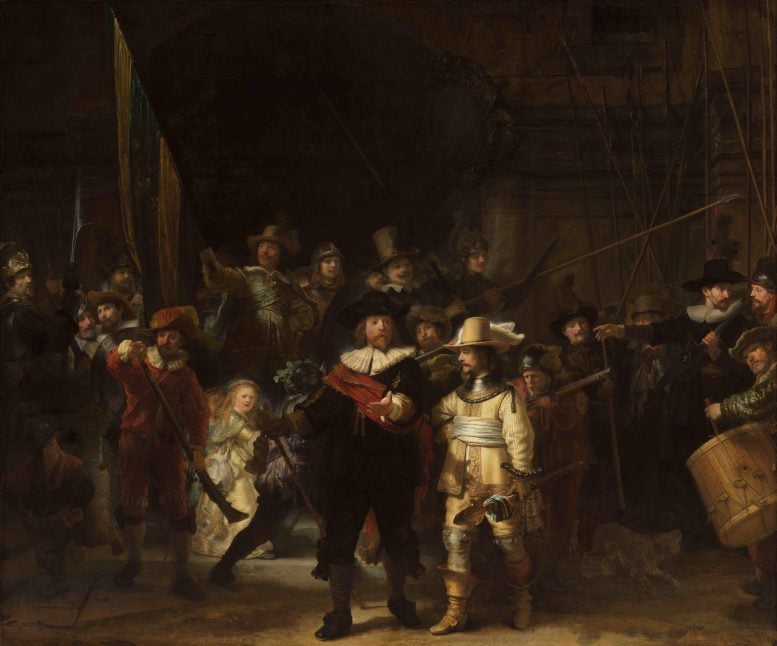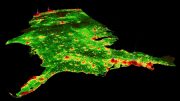
The Night Watch, Rembrandt van Rijn, 1642. Credit: Rijskmuseum Amsterdam
Scientists from the Rijksmuseum, CNRS, the European Synchrotron Radiation Facility, the University of Amsterdam, and the University of Antwerp made a rare discovery of lead formate in Rembrandt’s The Night Watch. This first-ever discovery in painting research offers a new understanding of 17th-century painting techniques and the conservation history of the artwork. The findings were published in the journal Angewandte Chemie – International Edition.
The Night Watch, an iconic masterpiece by Rembrandt is currently housed in the Rijksmuseum Amsterdam in The Netherlands. The painting, completed in 1642, underwent its largest-ever research and conservation project in 2019, known as Operation Night Watch. An international team of researchers studied the chemical reactions and aging of the painting materials during this project.

Crystalline phase distribution obtained via structural imaging on an area of The Night Watch (1642) by Rembrandt van Rijn (1606-1669). Credit: Antwerp X-ray Imaging and Spectroscopy Research group – University of Antwerp, Belgium
The team of scientists combined multi-scale imaging methods in order to chemically study the materials used by Rembrandt in The Night Watch. An X-ray scanning instrument developed at the University of Antwerp (Belgium) was applied directly to the painting, while tiny fragments taken from the painting were studied with synchrotron micro X-ray probes, at the ESRF, the European Synchrotron (France), and PETRA-III facility (Germany). These two types of analyses revealed the presence of an unexpected organo-metallic compound: lead formates.
This compound had never been detected before in historic paintings: “In paintings, lead formates have only been reported once in 2020, but in model paintings (mock-up, fresh paints). And there, surprise: not only do we discover lead formates, but we identify them in areas where there is no lead pigment, white, yellow. We think that probably they disappear fast, this is why they were not detected in old master paintings until now”, explains Victor Gonzalez, CNRS researcher at the Supramolecular and Macromolecular Photophysics and Photochemistry (PPSM) laboratory (CNRS/ENS Paris-Saclay) and first author of the paper.

Ida Fazlić, a Ph.D. student at the ESRF and co-author, during the experiment carried out at the European Synchrotron on tiny painting samples. Credit: ESRF / Stef Candé
Why did this one not disappear then? For Katrien Keune, head of science at Rijksmuseum and professor at the University of Amsterdam (the Netherlands), this finding is key to understanding Rembrandt better: “In Operation Night Watch we focus on Rembrandt’s painting technique, the condition of the painting and how we can best preserve it for future generations. The lead formate gives us valuable new clues about the possible use of lead-based oil paint by Rembrandt and the potential impact of oil-based varnishes from past conservation treatments, and the complex chemistry of historic oil paintings.”
What is the origin of this compound? Can it provide information on Rembrandt’s workshop recipes, or shed light on the chemical mechanisms active in the layers of old paint? To answer these questions, the scientists studied fragments taken from The Night Watch and model samples prepared in the laboratory simulating the painter’s formulations.
They worked with the hypothesis that Rembrandt used an organic medium (linseed oil) containing dissolved lead oxide (PbO litharge) to enhance its siccative properties. “Thanks to the unique analytical performance of the ESRF, the world’s brightest synchrotron light source, we could map the presence of formates at a micrometric scale, and follow their formation over time”, explains Marine Cotte, a scientist at the ESRF. The spatial organization of the compounds at the micro-scale and the dynamics of their formulation made it possible for the researchers to suggest new hypotheses on the chemical conditions of their in situ crystallization in old paint layers.
“In addition to providing information on Rembrandt’s pictorial techniques, this research opens up new avenues on the reactivity of historical pigments, and therefore on the preservation of heritage”, explains Koen Janssens, Professor at the University of Antwerp.
The next step for the team is to further study the origin of these formates and see if they could also originate from past restoration treatments.
Reference: “Lead(II) Formate in Rembrandt’s Night Watch: Detection and Distribution from the Macro- to the Micro-scale” by Dr. Victor Gonzalez, Ida Fazlic, Dr. Marine Cotte, Dr. Frederik Vanmeert, Arthur Gestels, Steven De Meyer, Fréderique Broers, Dr. Joen Hermans, Dr. Annelies van Loon, Prof. Koen Janssens, Petria Noble and Prof. Katrien Keune, 2 January 2023, Angewandte Chemie – International edition.
DOI: 10.1002/anie.202216478
Note: This research benefits from a facilitated access provided to the historical materials community to the synchrotron techniques at the ESRF, which has been implemented with support from the European Union’s Horizon 2020 research and innovation program under grant agreement No 870313, Streamline.









hello
The title _Night Watch_ is, of course, a misnomer.